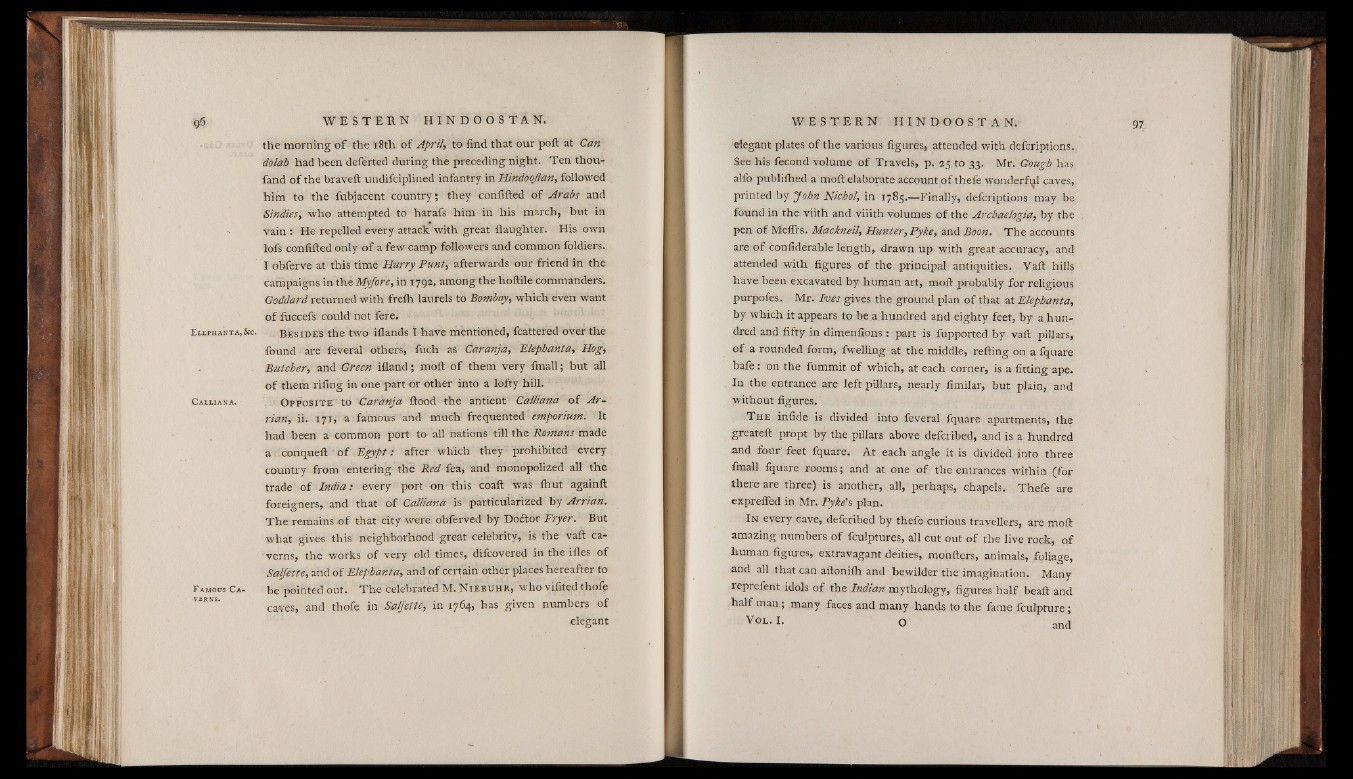
the morning o f the 18th of April, to find that our poft at Can
dolah had been deferted during the preceding night. Ten thou-
fand of the braveft undifciplined infantry in Hindooflan, followed
him to the fubjacent country; they confifted of Arabs and
Sindies, who attempted to harafs him in his march, but in
vain : He repelled every attack with great flaughter. His own
lofs confifted only o f a few camp followers and common foldiers.
I obferve at this time Hurry Punt, afterwards our friend in the
campaigns in the Myfore, in 179a, among the hoftile commanders.
Goddard returned with freih laurels to Bombay, which even want
o f fuccefs could not fere.
E i e p h a n t a , & c . R e s i d e s the two iflands I have mentioned, fcattered over the
found are feveral others, fuch as Caranja, Elephant a, Hog,
Butcher, and Green ifland; moft o f them very fmall; but all
of them riling in one part or other into a lofty hill.
O p p o s i t e to Caranja flood the antient Calliana of Arrian,
ii. 171, a famous and much frequented emporium. It
had been a common port to all nations till the Romans made
a conqueft o f Egypt: after which they prohibited every
country from entering the Red lea, and monopolized all the
trade o f India: every port on this coaft was ihut againft
foreigners, and that o f Calliana is particularized by Arrian.
The remains of that city were: ohferved by Doftor Fryer. But
what gives this neighborhood great celebrity, is the vaft caverns,
the works of very old times, difcovered in the illes of
Salfette, and of Elephant a, and of certain other places hereafter to
be pointed out. The celebrated M. N i e b u h r , who vifited thofg
caves, and thofe in Salfette, in 1764, has given numbers of
elegant
C a l l ia n a .
F a m o u s C a v
e r n s .
See his fecond volume o f Travels, p. 25 to 33. Mr. Gough has
alio publiihed a moft elaborate account of thefe wonderful caves,
printed by ’John Nichol, in 1785.— Finally, defcriptions may be
found in the viith and viiith volumes o f the Archaelogia, by the
pen of Meflrs. Mackneil, Hunter, Pyke, and Boon. The accounts
are o f confiderable length, drawn up with great accuracy, and
attended with figures of the principal antiquities. Vaft hills
have been excavated by human art, moft probably for religious
purpofes. Mr. Ives gives the ground plan o f that at Elephanta,
by which it appears to be a hundred and eighty feet, by a hundred
and fifty in dimenfions : part is fupported by vaft pillars,
of a rounded form, fwelling at the middle, refting on a fquare
bafe: on the fummit o f which, at each corner, is a fitting ape.
In the entrance are left pillars, nearly fimilar, but plain, and
without figures.
T h e infide is divided into feveral fquare apartments, the
greateft prdpt by the pillars above defcribed, and is a hundred
and four feet fquare. At each angle it is divided into three
fmall fquare rooms; and at one of the entrances within (for
there are three) is another, all, perhaps, chapels. Thefe are
exprefied in Mr. Pyke's plan.
In every cave, defcribed by thefe curious travellers, are moft
amazing numbers o f fculptures, all cut out o f the live rock, o f
human figures, extravagant deities, monfters, animals, foliage,
and all that can aftoniih and bewilder the imagination. Many
reprefent idols o f the Indian mythology, figures half beaft and
half man; many faces and many hands to the lame fculpture;
V S # O and